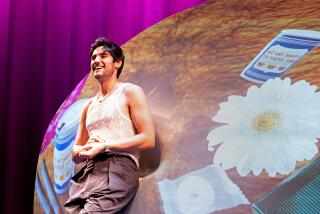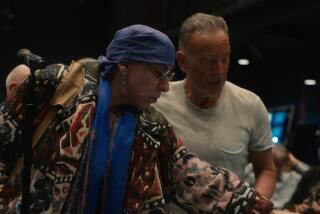MOVIE REVIEWS : Sex, Drugs and ‘The Doors’ : A rock critic says director Oliver Stone has turned the raw power and emotion of Jim Morrison’s music into an assault on the senses.
- Share via
“The Doors” film figured to be a risky creative alliance: Oliver Stone, a visionary but often heavy-handed director who seems to equate subtlety in movies with artistic surrender, and Jim Morrison, an equally passionate rock star who loved nothing better than stepping through doors marked forbidden.
And sure enough, the film is a wildly uneven work in which Stone focuses so strongly on Morrison and the forces that both drove and destroyed him that almost nothing else in the film--from historical accuracy to supporting characters--seemed to matter.
It’s a serious flaw that neutralizes to a large extent the brilliance of the concert sequences and leaves us with a film spectacle that is simultaneously glorious but hollow.
Many of the problems surface early as Stone, who co-wrote the script with J. Randal Johnson, leads us in the opening third of the movie through a soft parade of rock-bio cliches. Once again, we experience: restless, rebellious young man joins a rock band; band stumbles onto a hit sound during rehearsal; record company sharks circle; fans embrace them; band goes on “The Ed Sullivan Show,” and straight from “Don’t Look Back” and “A Hard Day’s Night”--the band uses a press conference to put down non-believers.
When the film gets past the obligatory cliches, it takes off and soars.
In terms of raw power and emotion, the best moments of the “The Doors” are to rock music what “Raging Bull” was to boxing, a thrilling assault on the senses so unflinching that the viewer is both seduced and repulsed.
Understandably, this is not a warm, winning rock ‘n’ roll nostalgia film--along the lines of either “The Buddy Holly Story” or “La Bamba.” True to the darkness and danger of the Doors’ music, it is a stark, sobering, often disillusioned look at someone fascinated with life’s potentials and limits, but ultimately not strong enough to confront either.
Morrison died in 1971 of an apparent heart attack in Paris, though there was always speculation that Morrison--who constantly flirted with death, either on ledge tops or in massive amounts of alcohol/drug consumption--committed suicide or died of an accidental overdose. He was 27.
In the rock film genre, “The Doors” is closer in spirit to “Don’t Look Back,” the brilliant, mid-’60s Bob Dylan documentary in which D.A. Pennebaker chronicled what it’s like to be moving into the absolute center of pop attention, and “Sid and Nancy,” Alex Cox’s account of the self-destructiveness of part of the late-’70s punk scene.
Stone has said in interviews that Morrison became a hero to him after first hearing the Doors’ music while serving in Vietnam. Like many of the ‘60s generation and a new wave of Doors fans today, Stone found something liberating and inspiring in Morrison’s search, through art and drugs, in an age that demanded new values and truths.
“Day destroys the night / Night divides the day / Try to run, try to hide / Break on through to the other side,” he sang and he made imaginations dance the way other rockers are only able to make audiences’ feet move.
Stone’s greatest asset in “The Doors” is Val Kilmer, who plays Morrison with a starmaking sense of empathy and style that should be equally involving whether you’re familiar with Morrison or not.
It’s challenge enough to portray a figure as famous as Morrison--a combination sex-God and martyr-king who ranks second only to Elvis Presley in the American Rock and Roll Hall of Tragedy--without also having to do much of his own singing in the film.
Yet Kilmer, whose classical training at Juilliard does not suggest the kind of raw, intuitive approach that lends itself to rock ‘n’ roll, captures both Morrison’s sensual heat on stage and his brooding confusion off.
And Stone uses the camera as if it were an extension of Morrison, allowing the viewer to feel the emotional interaction between the performer and the audience in a way we haven’t seen since Martin Scorsese’s “The Last Waltz.”
Just as Scorsese capsulized the drama of a 30-minute prize fight into a few scorching seconds in “Raging Bull,” Stone summarizes all that was electric about Morrison in a few memorable concert scenes--scenes that try to take us inside Morrison’s psyche to suggest images flashing through his troubled brain as he roamed the stage, sometimes barely able to maintain his balance as he delivered some of the Doors greatest songs and some of his clumsiest poetry.
Stone is equally effective in capturing Morrison’s descent, especially in an elaborate party scene in New York where Morrison becomes intoxicated by a stimulant more potent than anything he drinks from a bottle: fame.
As the emerging rock star moves through the crowd, hearing his name whispered and feeling his thigh brushed by admiring men and women, you sense the end is only a matter of time.
But there are limits to Stone’s examination of Morrison. He has done a remarkable job of transfering his Vietnam-era vision of Morrison to the screen, but he hasn’t expanded that vision in a way that illuminates Morrison’s character and motivation.
Morrison remains little more than the larger-than-life caricature that we know from pop history. In the words of the Doors song that may long haunt Stone, the director doesn’t break on through to the other side.
More to Read
Only good movies
Get the Indie Focus newsletter, Mark Olsen's weekly guide to the world of cinema.
You may occasionally receive promotional content from the Los Angeles Times.










